Thermostat for a heating battery - a useful addition to the
In winter, the temperature outside varies widely, in harsh winters the temperature can fall below -30? C, and during a thaw, the temperature can be quite positive. The heating system must adequately respond to weather conditions and regulate the temperature of the heating radiator.
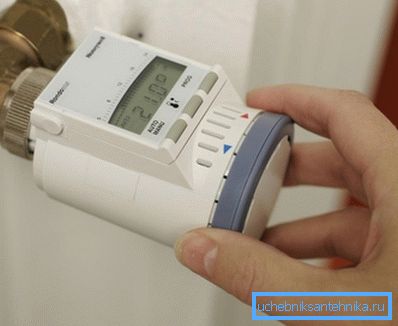
What is the benefit of installing the thermostat
The standard centralized heating system in a multi-storey building does not provide for the installation of any control devices in the apartment. As a result, tenants have little effect on the temperature in the apartment. In some cases, the batteries become hot and you even have to open the windows in winter, the thermostat is useful just in such cases - it will reduce the flow of coolant into the radiator, thereby reducing the temperature in the room.
To regulate the work of heating in several ways:
- Lovers of savings often use a conventional ball valve as a thermostat for radiators, but this is not the best option.. At best, it will be enough for a couple of seasons, and then guaranteed leakage of the coolant.
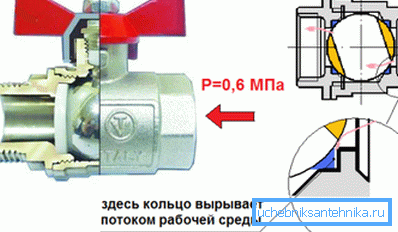
Note! For a ball valve, only the closed / open position is considered normal, to adjust the heating it is necessary to leave it in an intermediate position, this leads to the fact that solid inclusions in the coolant damage the closing ball and you can forget about tightness.
- the cone valve will last much longer, because its design allows it to remain in an intermediate position. A disadvantage of this device is that it is necessary to manually regulate the flow of coolant, that is, to constantly open and close the valve;
- automatic thermostats can be considered ideal. The design of this device allows you to perform the adjustment in automatic mode. From a person you only need to adjust the regulator immediately after installation. It is also important that the price of such devices is low, so that everyone can afford it.
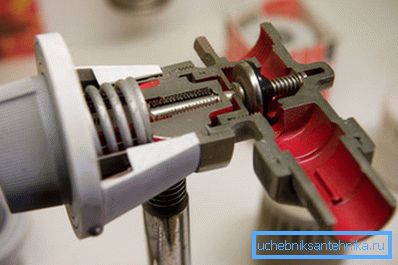
Classification of thermostats
You can select several types of thermostats:
- The simplest option is with mechanical adjustment. As an example, the above-mentioned cone valve can be cited. The accuracy of the adjustment in this case is low;
- in automatic devices due to the deformation of the bellows (the principle of operation is discussed below), the adjustment of the coolant current is performed automatically;
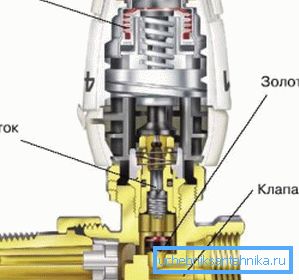
- It is worth noting and regulators with electronic control. In this case, the person simply needs to select the operating mode on the display or set the desired temperature in the room. Automation will do the rest itself.
You can select a group of devices with a remote temperature sensor. In this case, the sensor is located at a distance of several meters from the regulator, which allows it to more adequately respond to changes in air temperature in the room.
Note! A remote temperature sensor is the optimal solution for those cases when the heating battery is located in a deep enough niche and a conventional thermostat does not quite correctly track the change in air temperature in a room.
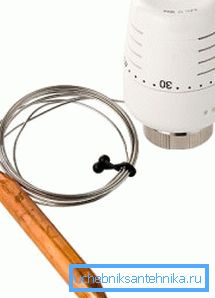
Heating can be regulated in a slightly different way. If you place the unit with a temperature sensor directly in the room, and the controller in the boiler room, you can change its temperature instead of adjusting the coolant flow. This approach makes sense when heating large rooms, because the heat emission of all radiators changes at once.
Some thermostats for radiators can control the temperature not in the room, but outside. This allows the heating system to respond quickly to changing weather conditions without waiting for the temperature in the room to change.
In the past, devices that directly monitored the temperature of the coolant in the system were popular (immersion sensors were used for this). Now such regulators are considered obsolete and practically not used.
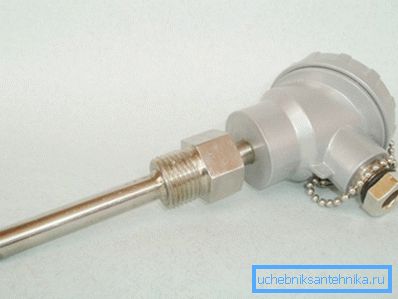
When choosing, you need to pay special attention to the labeling of the thermostat - there may be such options as:
- RTD-G - suitable for heating systems with natural circulation of the coolant. Can be used in both 2-pipe and 1-pipe systems;
- RTD-N - used in systems with forced circulation of the coolant.
The principle of operation and installation of the thermostat
Before installing the regulator, it will not be superfluous to become familiar with the principle of operation, the device and the rules for its placement. Despite the large number of models from different manufacturers, most regulators operate in the same way.
The principle of operation of the thermostat
The basis of the operation of the device for regulating the temperature of the heating radiator is the property of liquids and gases to expand / contract when heated / cooled. So, the principle of operation for gas and liquid models is the same, the difference is only in the speed of reaction to the temperature change in the room.
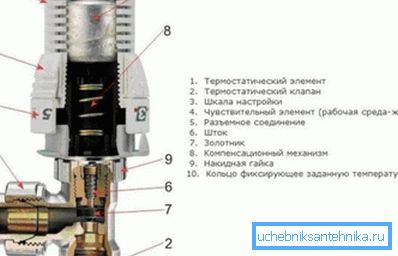
Note! Liquid thermostats for radiators are more inertial, that is, they respond more slowly to changes in temperature. Gas analogues from this point of view are preferable.
The bellows outwardly looks like a sealed chamber with corrugated walls inside which there is a gas or liquid. As the temperature in the room increases, the substance inside the bellows heats up and expands, causing an increase in the bellows length. Because of this, a movement of the valve regulating the size of the through-passage occurs.
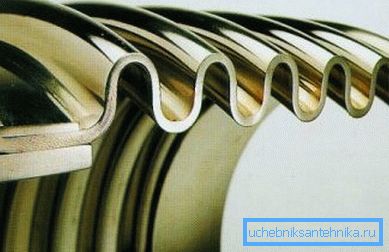
How to place the thermostat correctly
Effective adjustment of heating is possible only if the regulator is correctly positioned.
It is recommended to adhere to the following rules when installing:
- thermostat must be located on the supply pipe;
- if the radiator is located in a wall niche, it is forbidden to close it with curtains (even from light fabric). If this happens, the air in the closed space will heat up quickly and the regulator will limit the flow of coolant into the battery;
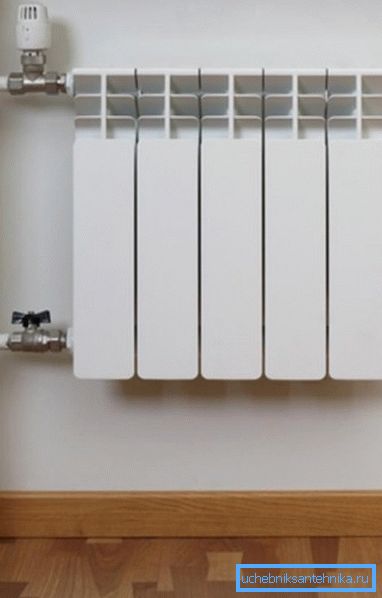
Note! If a device with a remote sensor is used, then the closed blinds will not interfere with the normal operation of the regulator.
- thermal head should be located perpendicular to the plane of the radiator. Thanks to this arrangement, the warm air that rises from the batteries does not affect the operation of the bellows, and it will be easier to regulate the operation of the device;
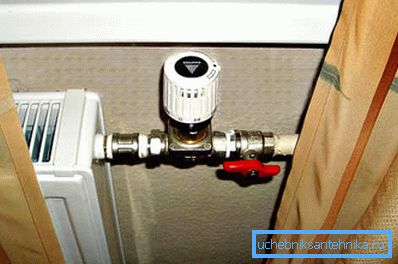
- it is desirable to combine the installation of the regulator with the replacement of the heating battery;
- Bypass installation will not be superfluous - if necessary, this will allow you to quickly and painlessly turn off the radiator from the operation of the heating system;
- The installation of regulating devices should always begin with the rooms in which the greatest temperature fluctuations are observed. In the private construction of the installation are, starting with the upper floors.
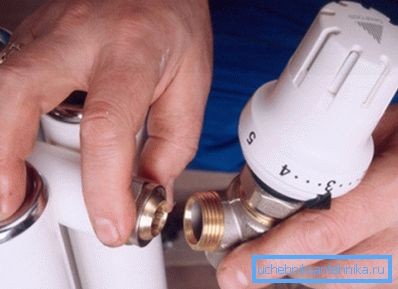
Installation and configuration manual for the thermostat
If you don’t have a familiar plumber on hand, you’ll have to do the installation yourself, it’s not so difficult.
Installation instructions are as follows:
- if there is no bypass, you will have to turn off the heating system for a while and drain the water from the system. With the bypass, everything will be much easier - just enough to turn off the battery from work and you can proceed to install;
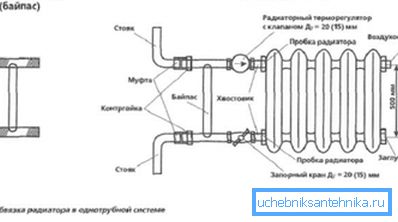
- In addition to the thermostat, the piping includes 2 ball valves (they will be needed to shut off the coolant current);
- If you plan to install a bypass, then you need to stock up with a pipe of the desired length.
Note! The bypass pipe diameter must be 1 size smaller than the diameter of the main pipeline. For example, if a pipe is used for heating? inch, then bypass you need to use the size? in.
For normal operation, a preliminary adjustment of the thermostat is required.
It is executed in the following sequence:
- first in the room you need to close all doors and windows and generally reduce air exchange to a minimum (turn off the hood if there is one);
- then the valve is fully opened and the coolant flows into the radiator without any problems, you need to wait until the room warms up (the temperature should be slightly higher than required);
- after that, the thermostat overlaps, that is, the valve turns all the way to the left, you need to wait until the room cools down to an acceptable temperature;
- now it remains only to fix the temperature in the room at the reached level. To do this, the valve slowly opens up until you hear the murmur of water, and it will not heat up. At this adjustment with your own hands can be considered complete.
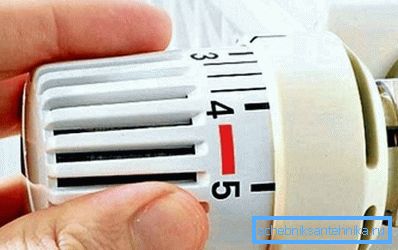
On the effectiveness of thermostats
There are many models on the market, but the effectiveness of most of them is comparable. On average, for the season, the savings compared to unregulated heating is about 15-20%. If the temperature variation in winter is large enough, the savings can reach 25-30%.
As for the cost, a high-quality thermostat can be bought for about 400-700 rubles, depending on the manufacturer. In this case, guaranteed compatibility with radiator valves of almost all well-known manufacturers, for example, DiaNorm, Arbonia, Ferroli, etc.
Summarizing
Using the thermostat is a great way to increase the efficiency of the heating system. At the same time, the increase in efficiency is understood as the possibility of flexible adjustment of the operation of individual radiators, if the temperature of the coolant is insufficient for normal heating of the room, the regulator will not help. The popularity of such devices is due not only to low price, but also ease of installation.
The video shows an example of the installation and adjustment of the thermostat for a battery with a wide range of temperature control options and several operating modes.